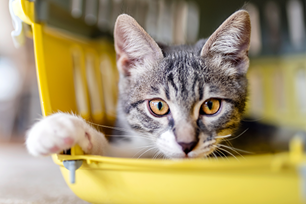Crate and travel training tips for cat owners!
Traveling with your cat is inevitable, whether it’s to your veterinarian, a trip across the state or country or when moving from one home to another. Getting your cat into its carrier is its own adventure!
The good news is you can help your cat become accustomed to their carrier and travel through positive reinforcement! While it’s true that it’s easier to train young kittens, crate training can start at any age. Finding the right crate for your cat can also play a part in the process. Research different types of crates, as some that open differently may be more appealing to certain pets. Your veterinarian can also suggest a few options!
In the meantime, here are our tips to help your cat feel comfortable while traveling:
- The number one tip for getting your cat used to their crate is to leave it out all the time in a quiet part of the main living area. Your cat is more likely to become comfortable with their crate if it’s a part of their daily life and is a familiar item.
- To encourage your cat to go into their crate, make it inviting with their favorite blanket or bed. Offer their food, tempting treats and food stuffed toys in their crate. At first, leave the door open when your cat goes inside.
- Pheromone sprays, such as Feliway® (a synthetic feline facial pheromone) can be helpful when training your cat. Facial pheromones are used by cats to mark their territory as safe. Spray Feliway® on your cat’s bedding to create a sense of security. Talk to your veterinarian for more information.
- Once your cat is used to going in and out of the crate, carefully close the door when they’re inside and walk away. After a short period, praise your cat and let them out. The next step is to carry the crate around your home.
- Once your cat is comfortable, try introducing them to your vehicle! Place the crate inside your vehicle giving your cat lots of praise and a treat; always praising and providing a treat, snuggles or a game once you return inside.
- After a few successful trips from your home to your vehicle, try starting the vehicle and turn on the heat or air conditioning so your cat can get used to the sounds and vibrations. Take your cat back inside after a few minutes and offer praise once again.
- After repeating steps 1 to 6 a few times over the course of several days or weeks (depending on your cat’s willingness) take a short drive around the block, gradually increasing the length of time you’re in the vehicle with your cat.
- Repeat this whole sequence until your cat is comfortable with travel. Go for drives from time to time so your cat maintains their comfort with car travel.
If during the training, your cat still displays signs of distress (like prolonged vocalization, trying to escape or salivation), talk to your veterinarian about ways to manage his or her anxiety.
Browse our veterinarian-approved calming pheromone diffusers and sprays. >>
